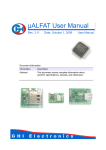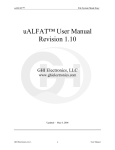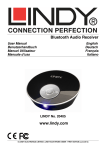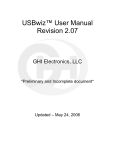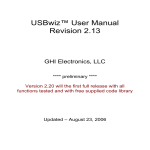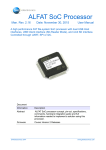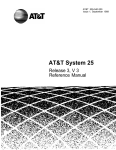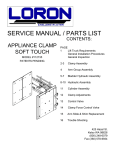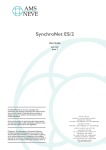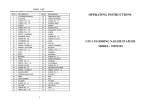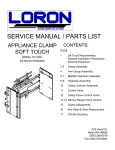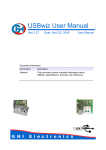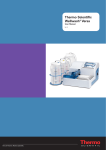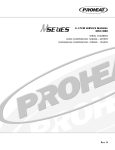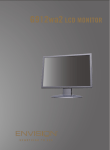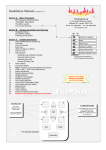Download ALFAT™ User Manual Revision 2.00
Transcript
µALFAT™ User Manual
Revision 2.00
GHI Electronics, LLC
** Preliminary document **
Updated – July 19, 2006
µALFAT™
File System Made Accessible
Table of Contents
1.
INTRODUCTION ............................................................................................................................... 3
1.1.
1.2.
1.3.
1.4.
1.5.
FAT FILE SYSTEM ..................................................................................................................................... 3
ADDING A FILE SYSTEM TO YOUR PRODUCT ................................................................................................ 3
µALFAT™ GENERAL DESCRIPTION ........................................................................................................... 3
KEY FEATURES ........................................................................................................................................ 3
SOME EXAMPLE APPLICATIONS ................................................................................................................. 3
2.
µALFAT™ PIN-OUT AND DESCRIPTION ....................................................................................... 3
3.
µALFAT™ BOOT LOADER.............................................................................................................. 3
3.1.
3.2.
3.3.
3.4.
4.
COMMANDING WITH µALFAT™ .................................................................................................... 3
4.1.
4.2.
4.3.
4.4.
5.
µALFAT™ GENERAL DESCRIPTION .......................................................................................................... 3
USING THE BOOT LOADER ........................................................................................................................ 3
BOOT LOADER COMMANDS ....................................................................................................................... 3
COMMUNICATION INTERFACES IN BOOT LOADER ........................................................................................ 3
SELECTING AN INTERFACE ........................................................................................................................ 3
UART INTERFACE .................................................................................................................................... 3
SPI INTERFACE MODE .............................................................................................................................. 3
I2C INTERFACE MODE .............................................................................................................................. 3
µALFAT™ FUNCTION...................................................................................................................... 3
FAT STORAGE MEDIA WITH µALFAT ..................................................................................................................... 3
•
Directories (folders)................................................................................................................................ 3
•
Files........................................................................................................................................................ 3
6.
µALFAT™ COMMANDS SET........................................................................................................... 3
6.1.
6.2.
6.3.
6.4.
6.5.
6.6.
6.7.
6.8.
6.9.
6.10.
6.11.
6.12.
6.13.
6.14.
6.15.
6.16.
6.17.
6.18.
6.19.
6.20.
6.21.
6.22.
6.23.
6.24.
V GET VERSION NUMBER ......................................................................................................................... 3
# ENABLE ECHO VERSION NUMBER........................................................................................................... 3
Z µALFAT SLEEP .................................................................................................................................... 3
T INITIALIZE TIMER ................................................................................................................................... 3
S SET CURRENT TIME AND DATE .............................................................................................................. 3
G GET CURRENT TIME AND DATE ............................................................................................................. 3
B SET UART BAUD RATE ......................................................................................................................... 3
I INITIALIZE AND MOUNT FILE SYSTEM ON MMC/SD................................................................................... 3
U INITIALIZE AND MOUNT FILE SYSTEM ON USB MASS STORAGE ............................................................... 3
K GET MEDIA STATISTICS ......................................................................................................................... 3
Q QUICK FORMAT MEDIA .......................................................................................................................... 3
@ INITIALIZE LIST FILES AND FOLDERS ...................................................................................................... 3
N GET NEXT DIRECTORY ENTRY ............................................................................................................... 3
M MAKE DIRECTORY ................................................................................................................................ 3
A CHANGE DIRECTORY............................................................................................................................. 3
E REMOVE DIRECTORY............................................................................................................................. 3
O OPEN A FILE FOR READ, WRITE OR APPEND ............................................................................................ 3
C CLOSE FILE HANDLE ............................................................................................................................. 3
F FLUSH FILE DATA .................................................................................................................................. 3
R READ FROM FILE................................................................................................................................... 3
W W RITE TO FILE ..................................................................................................................................... 3
P SEEK FILE ............................................................................................................................................ 3
D DELETE FILE......................................................................................................................................... 3
? FIND FILE OR FOLDER............................................................................................................................ 3
7.
POWER MODES ............................................................................................................................... 3
8.
POWER AND OSCILLATOR ............................................................................................................ 3
GHI Electronics, LLC.
2 of 27
User Manual
µALFAT™
File System Made Accessible
9.
SPECIAL FIRMWARE ...................................................................................................................... 3
10.
DEVELOPMENT AND OEM CIRCUIT BOARDS ............................................................................. 3
APPENDIX A: FIRMWARE ERROR CODES ........................................................................................... 3
APPENDIX B: BOOT LOADER ERROR CODES..................................................................................... 3
APPENDIX C: LICENSING........................................................................................................................ 3
GHI Electronics, LLC.
3 of 27
User Manual
µALFAT™
File System Made Accessible
1. Introduction
1.1. FAT file system
Memory cards are very popular these days. Their small size and rather huge storage
makes them ideal for digital cameras and MP3 players. Managing and organizing data on
a memory card is not an easy task. It requires a robust file system. There are many file
systems out there but FAT, which stands for File Allocation Table, is the most popular
one. FAT was introduced by Microsoft with DOS operating system and FAT is still
supported by all versions of Windows operating systems, even Windows XP. To be
compatible with PCs, many other companies developed their own FAT code for different
applications, such as digital cameras. There are three versions of FAT file system, FAT12,
FAT16 and FAT32.
1.2. Adding a file system to your product
Adding a file system, such as FAT, to a product can cost a company thousands of dollars.
A reliable FAT stack source code costs between $4,000 and $10,000. That is not all, FAT
is useless without driver for the connected media, an SD card for example. Understanding
the media, porting, compiling and linking are also other complicated steps. Further more,
adding USB memory support adds complication to the process. Our own research shows
that adding a file system to a product would take about 6 months or cost about $10,000!!!
1.3. µALFAT™ general description
µALFAT is a full FAT file system on a chip. µALFAT requires very few external
components to run. For communication, a simple microcontroller (PIC, AVR, basic
stamp…etc.) with UART, SPI or I2C can be used. µALFAT can access MMC and SD
memory cards directly and USB Mass Storage Devices through a USB Host Controller
(MAX3421E)
1.4. Key Features
FAT16 and FAT32 support.
Runs on UART, SPI or I2C.
Programmable UART (serial port) bud-rate.
Can open 4 files at the same time using file handles.
Fast startup and media reconnect, few milliseconds.
Fast file write and read, average to 60 Kbytes/Sec or more, including interface
overhead.
Supports Secure Digital (SD) and Multi Media Card (MMC)
Supports USB Mass Storage Devices like thumb flashes and card readers
No SD license is required.
Field upgradeable firmware through UART, SPI, or I2C.
Field upgradeable firmware through a file on the connected media!
GHI Electronics, LLC.
4 of 27
User Manual
µALFAT™
File System Made Accessible
Very few external components.
10-bit ADC.
RTC (Real Clock Time) capable of running of external battery.
Low power consumption, 12mA.
Three power modes.
All I/O pins are 5 volt tolerant.
Small surface mount package, LQFP 48 pin.
-40˚C to +85˚C temperature operating range.
Lead free.
1.5. Some Example Applications
Digital cameras
Printers
Digital picture viewer
MP3 players
Data logger
Automated machines
GHI Electronics, LLC.
5 of 27
User Manual
µALFAT™
File System Made Accessible
2. µALFAT™ Pin-Out and Description
Pin Name
1
2
4
5
6
7
8
9
10
11
12
13
14
15
16
17
18
19
20
21
22
23
24
25
26
27
28
31
36
37
Description
SD_MISO
SD_MOSI
VBAT
SD card signal
SD card signal
Power source for the internal RTC. Connect to 3V
battery or VCC. Always use 2 diodes to connect a
battery and VCC in case the battery runs out of
power.
VDD 1.8V
1.8V power source
RESET#
µALFAT reset signal, active low.
VSS
Ground
TRST#
Do not connect
TMS
Do not connect
TCK
Do not connect
X1
Pin 1 for 10 MHz oscillator
X2
Pin 2 for 10 MHz oscillator
UART_TX
UART mode: Transmit pin of UART (output)
SPI_DATARDY SPI and I2C modes: When high, it signals that
I2C_DATARDY µALFAT wants to send some data and the host must
read it
UART_RX
Receive pin of UART (input)
SPI_BUSY
SPI and I2C: When high, it signals that µALFAT is
I2C_BUSY
being busy and not ready for new data.
TDI
Do not connect
TDO
Do not connect
VCC
3.3V power source
I2C_SCL
Clock pin for I2C
VSS
Ground
RTXC1
Pin 1 for 32.768 KHz oscillator. Optional for RTC with
backup battery.
I2C_SDA
Data pin for I2C
SPI_SCK
Clock pin for SPI
SPI_MISO
Master In Slave out for SPI (output)
SPI_MOSI
Master Out Slave In for SPI (input)
RTXC2
Pin 2 for 32.768 KHz oscillator. Optional for RTC with
backup battery.
RTCK
Do not connect
DBGSEL
Do not connect
SPI_SSEL#
Slave Select for SPI (input)
VSSA
Analog Ground
CD_SSEL#
SD card signal
MISC
A miscellaneous pin. Functionality will be determined
in special releases
GHI Electronics, LLC.
6 of 27
User Manual
µALFAT™
File System Made Accessible
Pin Name
Description
38
39
42
43
44
USB host slave select
USB host reset
3.3V Power source
Ground
SD card signal. This pin must be high when RESET#
is low. Also, when sending deep sleep command, a
toggle on this pin will wake up µALFAT
UH_SSEL#
UH_RESET#
VCC
VSS
SD_SCK
BL#
WAKE
45
UH_GPX
USB host GPX
46
UH_INT
USB host interrupt
All pins that are not listed in the table above must be left unconnected. Always, consult
µALFAT-SD schematics. The pins ending with the symbol ‘#’ are active low.
GHI Electronics, LLC.
7 of 27
User Manual
µALFAT™
File System Made Accessible
3. µALFAT™ Boot Loader
3.1. µALFAT™ General Description
The boot loader is used to update the firmware of µALFAT. When there is a new firmware
release, you can simply download the file from our website and, using simple commands,
µALFAT can update itself. At power up µALFAT will send 2 characters ‘B’ and ‘L’
indicating that the boot loader is ready to load new file. To exit the boot loader and start
µALFAT firmware, send ‘R’ character. If µALFAT chip detects invalid firmware then it
returns ‘BL’ again. In such case, reprogramming µALFAT chip is required. If µALFAT
powers up in standalone mode, it will execute the firmware immediately, no BL will be
sent.
3.2. Using the Boot Loader
The easiest way to update µALFAT is by placing the new firmware on any SD card using
any PC and a card reader. Once you have the firmware on the card, connect the same
card to µALFAT. The file MUST be placed in the root directory, not in any folder. We
recommend using newly formatted media. Now you are ready to send the update
command. The command is 3 characters, LOK (Load OK)
The boot loader can load firmware from SD cards or from the interface (UART, SPI or
I2C) but not from USB memory.
If needed, a user can update the new firmware by sending it over SPI, I2C or UART. All
commands return ‘!‘ followed by the error number. Also, the boot loader will respond with
‘Wxx<CR>’ on every sector write, where xx is the sector number.
The firmware file is encrypted file. Loading an incorrect file on µALFAT can damage the
chip. Never tamper with the firmware files.
3.3. Boot Loader Commands
Command Use
R
Load and run µALFAT
firmware
LOK
Load firmware file from
connected media
W
Write one sector to internal
FLASH
Notes
If Boot loader return BL then
reprogramming µALFAT is required
Returns !00 if pass or !xx error code
Follow ‘W’ by the sector number then
512 bytes of sector data. Transaction
must be terminated by a checksum byte.
Checksum byte is calculated by adding
all 512 data bytes
V
Returns the loader version
Returned value is ASCII
Note: The boot loader is entirely separate program that loads µALFAT firmware. The
version number of the boot loader may not mach the version number of µALFAT. New
GHI Electronics, LLC.
8 of 27
User Manual
µALFAT™
File System Made Accessible
µALFAT chips come with no firmware loaded and must load the latest firmware
available on our website.
3.4. Communication Interfaces in boot Loader
The boot loader runs simpler drivers for UART, SPI and I2C. All drivers run in pooled
mode. Also, there are few things to keeping mind:
1. The processor runs at 10 MHz versus 70 MHz in firmware.
2. SPI clock has to be lower than 1.25 MHz
3. SPI driver is half duplex.
GHI Electronics, LLC.
9 of 27
User Manual
µALFAT™
File System Made Accessible
4. Commanding with µALFAT™
4.1. Selecting an Interface
µALFAT uses UART, I2C or SPI to communicate with any external microcontroller. At
power up, µALFAT samples SPI_SSEL# and SPI_SCK pins to determine what interface
to use. The following table describes the states
SPI_SSEL#
SPI_SCK
Interface
0
0
UART
0
1
Skip boot loader*
1
0
I2C
1
1
SPI
* Do not use.
4.2. UART Interface
In UART interface mode, UART_TX pin is used to send data to your microcontroller and
UART_RX pin to receive commands from your microcontroller. The default baud rate for
UART is 9600. Always use 8 bit with no parity and 1 stop bit. Baud rate is changeable
through BR command. CTS and RTS lines must be used to insure not loss of data at high
speeds. CTS pin is an input to µALFAT and when it is high µALFAT will not send data and
will wait for it to go low. CTS should be high as long as possible to not slow down
µALFAT. RTS pin is output from µALFAT and it is set high when µALFAT FIFO is full.
Depending on data transfer speed, RTS pin may never go high because µALFAT is
contentiously emptying the FIFO.
Note: The internal UART have hardware TX FIFO that is 16 byte long. After asserting
CTS, µALFAT may still send the internal FIFO, up to 16 bytes.
Important: µALFAT will NOT send any data if CTS pin is high! If this pin is not used then it
must be connected to ground.
4.3. SPI Interface Mode
In SPI mode six pins are used for communication, to implement slave SPI. Two pins are
used for handshaking. SPI_SSEL, SPI_SCK, SPI_MISO, and SPI_MOSI are the standard
SPI pins where SSEL is used for Slave Select, SCK is the Serial Clock, MISO is the data
line going from µALFAT to your microcontroller, and MOSI is the data line going from your
microcontroller to µALFAT.
The Handshaking lines are SPI_DATARDY and SPI_BUSY. When µALFAT has data to
send to the PC, it raises DATARDY line. The host (SPI master) must read the data from
µALFAT as fast as possible. Data and commands can be sent to µALFAT at any time
except when SPI_BUSY is high.
In the nature of SPI, the data flow is full duplex. On every SPI transaction, a data is
swapped between the master (your system) and the slave (µALFAT). This is great until
GHI Electronics, LLC.
10 of 27
User Manual
µALFAT™
File System Made Accessible
you need to read data from µALFAT but you don’t want to send a command. µALFAT
implements a software mechanism to handle this issue. Two special numbers are used to
handle the flow control. 0xFF and we will call it NDT (No Data Token) and 0xFE and will
call it HDT (Half Data Token)
Whenever µALFAT SPI sees NDT (again, it is 0xFF,) it will ignore it. This allows you to
read µALFAT without sending data. Of course you are sending NDT but it will be ignored
by µALFAT SPI driver.
This is everything you need to do if you are using numbers from 0 to 0xFD. Usually, this is
good in most cases as µALFAT commands are ASCII based and most users save files as
ASCII text. If you need to send 0xFF to µALFAT, you have to send HDT followed by NDT.
µALFAT will understand this as real 0xFF number and will not ignore it. For 0xFE, you
have to send HDT followed by HDT. Here is a simple example in ‘C’ language on how
your transmit routine should work:
SendData(char c)
{
if( (c==FF) || (c==0xFE) )
SendSPI(0xFE);
SendSPI(c);
}
If pooling is a preferred, it is possible to keep pooling µALFAT and not check DATARDY
pin at all. When there is no data, µALFAT will return NDT (0xFF)
Important: µALFAT requires the following in order for SPI to work:
SCK is output from your system.
SCK is idle high.
SCK is slower than 8 MHz in full power mode and slower than 1.25 in reduced
power mode
Data is shifted out MSB first.
Data is shifted on the rising edge.
4.4. I2C Interface Mode
Four pins are needed for I2C communication. The USER_I2C_SCL and USER_I2C_SDA
are the two I2C bus lines. I2C_DATARDY and I2C_BUSY lines work exactly the same
way as SPI_DATARDY and SPI_BUSY work except the interface is half duplex. When
DATARDY is high, you can’t send data to µALFAT until all the data is read and DATARDY
is back low.
µALFAT runs in slave I2C mode always. The slave address of µALFAT is 0xA4. This
address is fixed and can’t be changed.
GHI Electronics, LLC.
11 of 27
User Manual
µALFAT™
File System Made Accessible
5. µALFAT™ Function
The commands and response in µALFAT are made in a way where they can be understood
and read by a human and can be easily parsed by any simple 8-bit micro. Each command is
one character. Some commands take parameters and others don’t. For example, V
command doesn’t take any parameters and it returns the version number. On the other hand,
M requires parameter to run. M creates (makes) a folder on the accessed media device. ‘M
LOG’ creates a folder with the name LOG.
Also, every command must be terminated with Carriage return. This is the enter key on your
keyboard. When programming in ‘C’, it is ‘\r’ or 0x0D.The backspace key is supported in case
there is a need to discard the last entry. There are many restrictions that must be noticed or
µALFAT will not accept the command.
Commands must be one character.
Every command must have the exact number of arguments.
Spaces must be used whenever is required.
Extra spaces count as errors.
All numbers are hexadecimal.
So all commands are text based. User can use a terminal program to type in the commands
(if using a PC and RS323 level converter.) Also, any microcontroller can send commands to
write/read files/folders. In Hyper terminal, you will find it at “propertiesSettingsASCII
SetupAppend Line Feed”
Important: µALFAT doesn’t echo back the data by default. Use ‘# 1’ command to enable
echo if needed.
At power up µALFAT will send BL (Read boot loader section for more details.)
Follow BL by ‘R’ and you should get the following. No carriage return is needed.
GHI Electronics, LLC
uALFAT(TM) 1.xx
FAT Storage Media with µALFAT
µALFAT can connect to two kinds of storage media types. The media types are SD/MMC
cards and USB Mass Storage device (SCSI command subclass, bulk only protocol) which
includes thumb flash, USB hard drives and card readers. Keep in mind that all devices must
be formatted FAT16 or FAT32.
µALFAT can mount only one File System Media at a time, which means that all opened files
and operations in one file system will be terminated if you mount other file system media. For
example, if one file is currently open on SD card and then it was switched to a thumb flash,
this file handle will be automatically closed before mounting File system on thumb flash.
To access FAT Storage Media, two commands can be used. The first commands is I to
access SD/MMC, the other one is U to access USB Mass Storage Device Storage device.
GHI Electronics, LLC.
12 of 27
User Manual
µALFAT™
File System Made Accessible
Example1: Mount File System on MMC and make a folder:
I
!00
M FOLDER
!00
Example2: Mount File System on USB Mass Storage Device and make a folder:
U
!00
M FOLDER
!00
µALFAT doesn’t detect card removal or replacement. The final application must detect card
removal. Also, µALFAT doesn’t check the protection switch on SD cards. This means
µALFAT will write on protected cards.No harm will be caused to the card if removed as long
as no files were open for write.
For step-by-step on how to use the commands, consult µALFAT Tutorial.
µALFAT supports the original FAT file system where files are 8 characters long with
extension that is 3 characters long. No long file name is supported. This allows us to speed
up the file access time and simplify the user’s work.
• Directories (folders)
Folders are supported by µALFAT. And it is possible to move over Folders by CD
command.
User must be sure about the current folder that is working in be cause there is no
current way to retrieve the current location in folder tree
M FLDR this command will create “FLDR” folder
• Files
Files can be opened for read, write or append. Opening a file for read requires that the
file exists on the media. Opening a file for write requires that the file doesn’t exist on
the media. If the file that is being open for read already exists on the media, µALFAT
will erase the old folder. Opening a file for append will add data to a file if it exists. If
the file doesn’t exist then a new file will be made. With µALFAT you can open up to 4
files at the same time using file handles.
Handles are used for fast access to a file. If a user needs to log data to 2 files at the
same time, “VOLTAGE.LOG” and “CURRENT.LOG” file handles become very useful. To
do so, open VOLTAGE.LOG under handle 1 and CURRENT.LOG under handle 2.
Now start sending your data to handle 1 and 2 instead to the file name.
Example:
To do so, open VOLTAGE.LOG under handle 1 and CURRENT.LOG under handle 2.
Now start sending your data to handle 1 and 2 instead to the file name.
To open a file use,
GHI Electronics, LLC.
13 of 27
User Manual
µALFAT™
File System Made Accessible
O 1W VOLTAGE.LOG
The previous command will create new file at the current directory with name
“VOLTAGE.LOG” and the file handle is 1. Now to save data to that file use
W 1>10
Now the “W” will write data to a file that is open at handle 1 and will write 16 bytes (10
hexadecimal = 16 decimal) to it. After sending carriage return (enter,) uALFAT will
return !00. This indicates that µALFAT is ready for your data. Now, start sending your
16 byte of data. When 16 bytes are sent, µALFAT will return another error code.
Note: All numbers given to µALFAT commands are hexadecimal numbers.
This is an example session:
>M LOG_DATA
!00
>A LOG_DATA
!00
>O 1W>VOLTAGE.LOG
!00
>O 2W>CURRENT.LOG
!00
>W 1>7
!00
12.123V
!00
>W 7>A
!00
1234567890
!00
W 1>7
!00
10.194V
!00
>
create new directory
change directory
create new file for write inside LOG_DATA folder
create new file for write inside LOG_DATA folder
command to write 7 bytes (characters) to file at handle 1
µALFAT accepted the write command
enter the data to go to the file
data written successfully
writes 10 bytes to file at handle 7
µALFAT accepted the write command
enter your data
data written successfully
add 7 bytes(characters) to file at handle 1
µALFAT accepted the write command
enter the data to go to the file
data written successfully
µALFAT is ready for more commands.
Note1: file names must not contain its path (i.e. “\sub1\file.txt”). Only pure names are
allowed (i.e. “file.txt”).
Note2: Folders and files use naming convention that is same of DOS naming
convention. Names must be 8 characters or less and 3 characters or less for the
extension and they must be upper case. All upper case letters, numbers and
underscore’_’ can be used for names and extensions.
Example “DATA.LOG”, “NOEXT”, “FOLDER”, “FOLDER.123”, “NO_SPACE.TXT”,
“12345678.123”
If an error occurred, µALFAT returns the symbol ‘!’ followed by the error number.
GHI Electronics, LLC.
14 of 27
User Manual
µALFAT™
File System Made Accessible
6. µALFAT™ Commands Set
All commands below are entered in ASCII. We choose to use ASCII to simplify
troubleshooting and to allow humans to enter commands easily. A special case is when
accessing the data inside or outside a file. When writing/reading to/from a file or USB Pipe,
µALFAT will use any kind of data. Basically, what you send is what goes on the file. It doesn’t
have to be ASCII.
When µALFAT is done processing a command, it will return an error code in the form
“!xx<CR>” where xx is the error number. Also, some commands require returning some extra
information. Returned data will come after the symbol $, unless noted otherwise.
You can send multiple commands to µALFAT until its FIFO is full (indicated by BUSY or
RTS.) µALFAT will take the commands in one at the time, process them and send responses
for each one. Always terminate commands with carriage return character.
Note: in all commands descriptions of their outputs will consider the successful executing of
the command
6.1. V Get Version Number
It prints the version number of µALFAT firmware. Note that this version is not same or
related to the version number of the boot loader. The return value is always in the form
“µALFAT x.xx”
Format: V
6.2. # Enable Echo Version Number
µALFAT by default does not echo back the data that it received from the host, it Echo is
required this command can be used.
Format:
# n n = 0 Disable echo
n = 1 Enable echo
Example: # 1 Enable echo
6.3. Z µALFAT Sleep
Read Power Modes Section for details.
Format: Z F
Full power consumption
Z R Reduced Mode
Z H Hibernate Mode
GHI Electronics, LLC.
15 of 27
User Manual
µALFAT™
File System Made Accessible
6.4. T Initialize Timer
Format: T S
TB
Share Mode. the RTC runs from "shared" clock and power like
processor
Backup Mode. it can run from a battery with a separate oscillator so it
will keep the time even if the processor is off
6.5. S Set Current Time and Date
Format:
S ddddtttt
ddddtttt time and date 32bit structure*
Example: S 34210000 Set 1/1/2006 00:00:00
6.6. G Get Current Time and Date
Format: T X
TF
Get 32bit standard time and date structure*
Get time and Date in a formatted way to be understandable for human
* Time and Date structure is a DWORD Standard structure in FAT system.
Bits(s)
31..25
24..21
20..16
15..11
10..5
4..0
Field
Year1980
Month
Day
Hour
Minute
Second2
Description
Years since 1980
1..12
1..31
0..23
0..59
Seconds divided by 2 (0..30)
6.7. B Set UART Baud Rate
µALFAT contains a fancy divider for baud rate. Using the divider we can set the UART to
almost any possible baud rate. Below is a table with some standard baud rates. Note that
the values do not work in boot loader. Always run boot loader at default 9600 and after
firmware execution, change the baud rate. The table contains two sets of divider values,
at 10 MHz and 70 MHz. Use the 70 MHz when run in full power mode and the 10 MHz
when running reduced power mode.
Baud Rate
9600
119200
38400
57600
115200
230400
460800
921600
Divider at 70 MHz
DCEF
6EEF
37EF
43F2
1EF4
0FF4
05A9
028B
Divider at 10 MHz
1FAB
0386
067C
08E5
04E5
02E5
01E5
Not possible!
For example: B 1EF4 will set the baud rate to 115200 when using full power mode.
µALFAT responds with !00 if command is accepted at the old baud rate and then it
changes the baud rate. You will then receive a second !00 at the new baud rate.
GHI Electronics, LLC.
16 of 27
User Manual
µALFAT™
Format:
File System Made Accessible
B vvvv
vvvv: WORD HEX Baud Rate Divider
Example: B 1EF4 Baud Rate is 115200
6.8. I Initialize and Mount File System on MMC/SD
It is a major initializing Command which is used to mount File System on a newly attached
MMC/SD, or to re-mount it. All file handles will be close automatically when using this
command.
Format: I
6.9. U Initialize and Mount File System on USB Mass Storage
It is a major initializing Command which is used to mount File System on a newly attached
USB Mass Storage Device like USB thumb flash, or to re-mount it. All file handles will be
close automatically when using this command.
In case that the Mass Storage device has more than one Logical Unit – like Card Readers
– the first Unit will be used.
Format: U
6.10. K Get Media Statistics
Format: K
!00
$ssssssss $ffffffff
!00
ssssssss HEX DWORD Media Size
ffffffff HEX DWORD Free Size
6.11. Q Quick Format Media
This command resets File Allocation Only. No change occurs to Boot Sector or MBR
Format: Q CONFIRM FORMAT
Note: the function will not be executed till the right confirming string follows the command
6.12. @ Initialize List Files and Folders
It sets List Files and Folders Function pointer to the first Directory entry in the current root.
Format: @
Related Command: N
6.13. N Get Next Directory Entry
This command will print out the Directory Entry “File or Folder” and increments List Files
and Folders pointer.
GHI Electronics, LLC.
17 of 27
User Manual
µALFAT™
Format:
File System Made Accessible
N
!00
NNNNNNNN.EEE AA ssssssss
!00
Example: N
!00
TEST0001.TXT 00 0000FE23
!00
N
!00
TEST0002.TXT 00 00001234
!00
NNNNNNNN File Name
EEE File Extension
AA HEX Byte File Attributes*
ssssssss HEX DWORD File Size
Passing N command two times and get
the results.
Related Command: @
* File Attributes are one byte Standard Attribute Structure in FAT system.
7
6
5
4
3
2
2
0
Reserved Archive Folder Volume ID System Hidden Read Only
6.14. M Make Directory
It creates a folder
Format:
M foldername
foldername follows the short name formation
Example: M MYFOLDER Create a folder with name MYFOLDER
6.15. A Change Directory
It changes the current folder access. Folder must exist.
Format:
A foldername
foldername follows the short name formation
Example: A MYFOLDER The current root is in MYFOLDER
6.16. E Remove Directory
This command removes Directory. The directory must be empty from any files or
subdirectories.
Format:
E foldername
Foldername follows the short name formation
Example: E MYFOLDER Remove the folder with name MYFOLDER
6.17. O Open a file for read, write or append
To open a file for read, write or append in the current Folder, use OF command. The
commands require a file handle and the access mode.
Open Modes are:
GHI Electronics, LLC.
18 of 27
User Manual
µALFAT™
File System Made Accessible
‘R’ Open for read requires the file to already exist in the current media and the current
accessed folder.
‘W’ Open for read will create a new file and give write privilege to it. If the file already
exists, it will be erased first then will open a new one for write.
‘A’ Open for append is similar to write with one exception. If the file already existed, it
will be opened and the incoming data will be appended at the end.
Important Note: The file name must be in standard short name “8.3” formation.
Note: µALFAT currently has 4 available file handles.
Format:
O nM>foldername
Open file foldername to file handle n with
access mode M which can be R,W or A.
Example: O 1R>VOLTAGE.LOG
Open file VOLTAGE.LOG to file handle 1 with
READ access mode.
O 0W>CURRENT.LOG
Open file CURRENT.LOG to file handle 0 with
WRITE access mode.
Related Commands: C, F, R, P and W
6.18. C Close File Handle
This command closes the opened file and updates file parameters in the file system and
confirm that all data in file buffer is written to the media. Then it releases the file handle to
be available for new file opening.
It is an important command, especially for file functions that add or modify on files to
confirm that data is written on the media and file parameters are updated.
Format:
C n Close File handle n
Example: C 0 Close File handle 0
Related Commands: O, F, R and W
6.19. F Flush File Data
This command does the same function of CF function except releasing the file handle. So
it updates file parameters and flushes file buffer data into storage media and keep file
handle ready for another write command.
It is made especially for file functions that add or modify on files to confirm that data is
written on the media and file parameters are updated.
Format:
F n Close File handle n
Example: F 0 Close File handle 0
Related Commands: O, C and W
GHI Electronics, LLC.
19 of 27
User Manual
µALFAT™
File System Made Accessible
6.20. R Read from File
Sending R with the file handle and the byte count and µALFAT will return your data. The
file must be opened for read first. To read more data from the file, send another R. If
µALFAT couldn’t get all the data it promised to return, it will send a filler symbol instead. It
is up to the user to decide what the filler is going to be.
Format:
R nM>ssssssss
n File Handle
M Filler Character
!00
ssssssss Bytes is ssssssss HEX DWORD desirable data size to be read
aaaaaaaa HEX DWORD actual read data from file size
returned
$aaaaaaaa
!00
Example: We have a file with 8 bytes (ABCDEFGH) in it, and it is opened for read with
handle number 2.
R 2Z>5
!00
ABCDE
$00000005
!00
R 2Z>5
!00
FGHZZ
$00000003
!00
Read 5 bytes from a file #2 with filler Z
µALFAT accepted the command
This is the data coming from the file
All 5 bytes are valid
No errors has occurred
Read more data. We will request 5 but only 3 are left
No errors has occurred
µALFAT returned the last 3 bytes but added 2 fillers
µALFAT indicating it was able to read 3 bytes only
µALFAT no error indication
Related Commands: O, C, and P
6.21. W Write to File
After a file is opened for write, you can use W to write to that file handle. After W
command, µALFAT will respond with error code. If the error code is !00 then writing data
to the file is ready. Now, everything goes into the interface goes directly to the file with no
interpretation what so ever. After sending all requested data, µALFAT will return the actual
write count. In some instances µALFAT could fail writing all the data and it will inform the
user of the data loss. Finally, W returns another error code. You can send as many W as
you need to write more data to the file. We recommend sending small block of data,
around 100 bytes.
W n>ssssssss
!00
User sends data
$aaaaaaaa
!00
Example: W 1>10
!00
1234567890abcdef
$00000010
Format:
GHI Electronics, LLC.
n File Handle
ssssssss HEX DWORD desirable data size to be
written
aaaaaaaa HEX DWORD actual written data to file size
Write 16 bytes to the file opened for handle 1
µALFAT accepted the command
16 bytes of data to go into the file
µALFAT was able to write 16 bytes
20 of 27
User Manual
µALFAT™
File System Made Accessible
!00
No errors has occurred
Related Commands: O, C and F
6.22. P Seek File
This command changes the file pointer position. File must be opened in Read-Mode.
Format:
P n>ssssssss
n File Handle
ssssssss HEX DWORD new position
Set file pointer at position the 16th byte in file, supposing
that its size is less than 16 bytes
Example: P 1>10
Related Commands: O and R
6.23. D Delete File
Format:
D filename
filename follows the short name formation
Example: D TEST.TXT Remove the file with name TEST.TXT
6.24. ? Find File or Folder
This command search for a specific file or folder name in the current folder and print out
file’s major information which includes size, attributes and date & time of modification.
Format:
? filename
!00
$ssssssss $AA $ddddtttt
!00
filename follows the short name formation
ssssssss HEX DWORD File Size
AA HEX Byte File Attributes*
ddddtttt HEX DWORD time and date
structure**
Example: ? TEST.TXT
!00
$00000F34 $00 $ 34210000
!00
File has been found and its size is 3892
bytes with no special attributes.
Last modification time is 00:00:00 date is
1/1/2006
* File Attributes are one byte Standard Attribute Structure in FAT system.
7
6
5
4
3
2
2
0
Reserved Archive Folder Volume ID System Hidden Read Only
** Time and Date structure is a DWORD Standard structure in FAT system.
Bits(s)
31..25
24..21
20..16
15..11
10..5
4..0
Field
Year1980
Month
Day
Hour
Minute
Second2
GHI Electronics, LLC.
Description
Years since 1980
1..12
1..31
0..23
0..59
Seconds divided by 2 (0..30)
21 of 27
User Manual
µALFAT™
File System Made Accessible
7. Power Modes
In some applications power consumption is very critical. µALFAT is designed with low
power in mind. Although you can completely shut off µALFAT’s power for zero power
consumption, some user may prefer to put µALFAT to sleep instead of power off to
keep the file handles open. Also, µALFAT can run at 2 different speeds.
µALFAT oscillator is 10 MHz. When executing the boot loader or the firmware,
µALFAT runs in reduced power mode. In this mode, µALFAT draws about 8mA
including 1.8V regulator.
If high performance is required, you can run µALFAT at full power where the core runs
at 70 MHz. In this mode, the complete µALFAT-SD board draws about 38mA.
Hibernation is also another option. If the system doesn’t need and file operations,
µALFAT can hibernate and the core draws about 10uA. Keep in mind that regulators
have their own current draw and a minimum draw. µALFAT-SD board draws 1mA
when in hibernate.
The command to change the power mode is ‘Z’. When changing the clock speed, you
have to keep many things in mind. For example, the SPI clock can be the system clock
divided by 8 maximum. So if the system is in reduced power mode running at 10 MHz,
the SPI SCK can be 1.25 MHz maximum. Also, the UART baud rate needs to be
adjusted to hold the correct divider value. Look at “UART Baud Rate” section for more
details on the divider values.
Z F>DCEF
switch to run at 70 MHz and set the UART baud rate to 9600.
Z R>1FAB
set the system to run at 10 MHz and baud rate of 9600
Now, what if we are using SPI or I2C interfaces? Even in this case you are required to
set the UART divider and you can use any one of the values.
When µALFAT goes in hibernation mode, it can be woken up by toggling the WAKE
pin. This in is multi purpose and must always be left disconnected from your system
except when there is a need to wake µALFAT. This can be accomplished by setting
the pin of your micro that connects to WAKE to be input. When there is a need to wake
µALFAT, set your pin to low then make the pin output, wit for few micro seconds and
then set the pin back to input.
GHI Electronics, LLC.
22 of 27
User Manual
µALFAT™
File System Made Accessible
8. Power and Oscillator
µALFAT is very simple to add to your new or existing designs, it requires very few
components. Two voltages are needed; 3.3V and 1.8V, crystal and very few RCs,
Check the pin description and schematics for more details. You can also find more
details on the chipset base (LPC2103) data sheet on Philips website
www.semiconductors.philips.com and the schematics of µALFAT-SD and µALFATUSB on our website www.ghielectronics.com µALFAT requires MAX3421E to run if
USB access is neede.
9. Special Firmware
µALFAT’s standard firmware contains many features to suite any application. If your
application requires a special need, we can implement a special firmware to suite your
needs. Loading the updated firmware or special firmware is extremely easy. Look at
the boot loader section.
10. Development and OEM Circuit
Boards
µALFAT-SD is our µALFAT chip on a small size board. The low cost and the ease of
use make µALFAT-SD the ultimate solution for OEMs or hobbyists. The SD/MMC
media connector is placed on one side of the board, making it possible to mount the
µALFAT-SD board inside your product case using 90 degree brackets. The full
schematic and board layout is on our website www.ghielectronics.com.
µALFAT-SD board contains 1.8 V regulator onboard. You will only need 3.3V for
power. The pin out of the board gives you access to SD card detect and pins to all
µALFAT’s signals.
µALFAT-USB is the USB version of µALFAT-SD.
We are also capable of designing special boards to fit your needs.
GHI Electronics, LLC.
23 of 27
User Manual
µALFAT™
File System Made Accessible
Appendix A: Firmware Error Codes
Error Number
0x00
0x01
0x02
0x03
0x11
0x12
0x13
0x14
0x15
0x21
0x22
0x23
0x24
0x25
0x31
0x32
0x33
0x34
0x35
0x40
0x41
0x42
0x43
0x44
0x45
0x46
0x47
0x48
0x49
0x4A
0x4B
0x4C
0x4D
0x4E
0x4F
0x61
0x62
0x63
0x64
0x65
0x66
0x67
0x68
0x69
GHI Electronics, LLC.
Description
No Error
ERROR_READ_SECTOR
ERROR_WRITE_SECTOR
ERROR_ERASE_SECTOR
ERROR_MBR_SIGNATURE_MISSMATCH
ERROR_BS_SIGNATURE_MISSMATCH
ERROR_SECTOR_SIZE_NOT_512
ERROR_FSINFO_SIGNATURE_MISSMATCH
ERROR_FAT12_NOT_SUPPORTED
ERROR_CLUSTER_OVER_RANGE
ERROR_CLUSTER_UNDER_RANGE
ERROR_NEXT_CLUSTER_VALUE_OVER_RANGE
ERROR_NEXT_CLUSTER_VALUE_UNDER_RANGE
ERROR_NO_FREE_CLUSTERS
ERROR_FILE_NAME_FORBIDDEN_CHAR
ERROR_FILE_NAME_DIR_NAME_OVER_8
ERROR_FILE_NAME_DIR_EXTENSION_OVER_3
ERROR_FILE_NAME_FIRST_CHAR_ZERO
ERROR_MEDIA_FULL
DIR_ENT_FOUND
DIR_ENT_NOT_FOUND
ERROR_FOLDER_IS_CORRUPTED_FIRST_CLUSTER
ERROR_FOLDER_IS_CORRUPTED_DIR_DOT_NOT_FOUND
ERROR_FOLDER_IS_CORRUPTED_DIR_DOTDOT_NOT_FOUND
ERROR_ROOT_DIRECTORY_IS_FULL
ERROR_OPEN_FOLDER_FILE
ERROR_WRTIE_TO_READ_MODE_FILE
ERROR_SEEK_REQUIER_READ_MODE
ERROR_INVALID_SEEK_POINTER
ERROR_FOLDER_NOT_EMPTY
ERROR_IS_NOT_FOLDER
ERROR_READ_MODE_REQUIRED
ERROR_END_OF_DIR_LIST
ERROR_FILE_PARAMETERS
ERROR_INVALID_HANDLE or ERROR_HANDLE_IN_USE
ERROR_COMMANDER_BAD_COMMAND
ERROR_COMMANDER_STR_LEN_TOO_LONG
ERROR_COMMANDER_NAME_NOT_VALID
ERROR_COMMANDER_NUMBER_INVALID
ERROR_COMMANDER_WRITE_PARTIAL_FAILURE
ERROR_COMMANDER_UNKNOWN_MEDIA_LETTER
ERROR_COMMANDER_FAILED_TO_OPEN_MEDIA
ERROR_COMMANDER_INCORRECT_CMD_PARAMETER
ERROR_CHECK_SUM
24 of 27
User Manual
µALFAT™
0x7A
0x7B
0x7C
0x7D
0x7E
0x7F
0x80
0x81
0x82
0x83
0x91
0x92
0x93
0x94
0x95
0x96
0xA0
0xA1
0xB1
0xB2
0xB3
0xB4
0xB5
0xB6
0xB7
0xB8
0xB9
0xBA
0xBB
0xBC
0xBD
0xBE
0xBF
0xFD
GHI Electronics, LLC.
File System Made Accessible
ERROR_USBD_DESCRIPTOR_CORRUPTED
ERROR_DESCRIPTOR_NOT_FOUND
ERROR_USB_HUB_NOT_FOUND
ERROR_HCD_USB_DEVICE_NOT_CONNECTED
ERROR_HCD_INIT_FAIL
ERROR_HCD_INDEFINED_CASE
ERROR_SD_UNEXPECTED_VALUE
ERROR_MMC_INIT_TIMEOUT
ERROR_SET_BLOCK_SIZE_FAIL
ERROR_MMC_SEND_COMMAND_FAIL
ERROR_BOMS_CSW_COMMAND_FAILD or
ERROR_USB_MASSSTORAGE_COMMAD_FAILED
ERROR_BOMS_CSW_STATUS_PHASE_ERROR
ERROR_BOMS_CSW
ERROR_BOMS_WORNG_LUN_NUMBER
ERROR_BOMS_WORNG_CSW_SIGNATURE
ERROR_BOMS_WORNG_TAG_MISSMATCHED
ERROR_USB_MASS_STORAGE_DEVICE_NOT_READY
ERROR_USB_MASSSTORAGE_NOT_FOUND
ERROR_HCD_BUSY
ERROR_HCD_BADREQ
ERROR_HCD_UNDEF
ERROR_HCD_NAK
ERROR_HCD_STALL
ERROR_HCD_TOGERR
ERROR_HCD_WRONGPID
ERROR_HCD_BADBC
ERROR_HCD_PIDERR
ERROR_HCD_PKTERR
ERROR_HCD_CRCERR
ERROR_HCD_KERR
ERROR_HCD_JERR
ERROR_HCD_TIMEOUT
ERROR_HCD_BABBLE
ERROR_COMMANDER_UNKNOWN_ERROR
25 of 27
User Manual
µALFAT™
File System Made Accessible
Appendix B: Boot Loader Error Codes
Error
Number
0xD2
0xD3
0xD4
0xD7
0xD8
0xDA
0xDB
0xDE
GHI Electronics, LLC.
Description
ERROR_VERIFY
ERROR_INTERNAL
ERROR_CHECKSUM
ERROR_INVALID_FRMWARE
ERROR_BR_COMMAND
ERROR_FILE_IS_EMPTY
ERROR_FILE_NOT_FOUND
ERROR_UNKNOWN_COMMAND
26 of 27
User Manual
µALFAT™
File System Made Accessible
Appendix C: Licensing
Each µALFAT chip comes with unconditional license of use from GHI Electronics, LLC.
There are many patented technologies utilized in µALFAT that must be account for.
• The SD card is used in MMC compatibility mode; therefore, no license is required from
the SD organization.
• FAT file system is a patent of Microsoft Corporation. Licensing fee for using FAT file
system must be paid by companies who wish to use FAT file system in their products. For
more information, visit Microsoft’s website.
http://www.microsoft.com/mscorp/ip/tech/fat.asp
Please note that our products don’t support long file names and most likely you don’t need
to pay any licensing but you should contact Microsoft for more details.
µALFAT uses USB through USB host controllers, no USB licensing is necessary.
Copyright GHI Electronics, LLC. Trademarks are owned by their respective companies.
ALFAT, µALFAT, ALFATxp, USBwiz and USBizi are trademarks of GHI Electronics, LLC
………………… DISCLAIMER …………………
IN NO EVENT SHALL GHI ELECTRONICS, LLC. OR ITS CONTRIBUTORS BE LIABLE
FOR ANY DIRECT, INDIRECT, INCIDENTAL, SPECIAL, EXEMPLARY, OR
CONSEQUENTIAL DAMAGES (INCLUDING, BUT NOT LIMITED TO, PROCUREMENT OF
SUBSTITUTE GOODS OR SERVICES; LOSS OF USE, DATA, OR PROFITS; OR
BUSINESS INTERRUPTION) HOWEVER CAUSED AND ON ANY THEORY OF LIABILITY,
WHETHER IN CONTRACT, STRICT IABILITY, OR TORT (INCLUDING NEGLIGENCE OR
OTHERWISE) ARISING IN ANY WAY OUT OF THE USE OF THIS SOFTWARE, EVEN IF
ADVISED OF THE POSSIBILITY OF SUCH DAMAGE.
COMPANIES, WHO UNITIZE ALFAT OR µALFAT or µALFAT IN THEIR PRODUCTS, MUST
CONTACT MICROSOFT CORPORATION FOR FAT FILE SYSTEM LICENCING. GHI
ELECTRONICS, LLC SHALL NOT BE LIABLE FOR UNPAID LICENSE.
SPECIFICATONS ARE SUBJECT TO CHANGE WITHOUT ANY NOTICE.
GHI Electronics, LLC.
27 of 27
User Manual



























